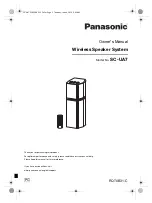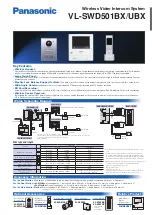
4
WALL AND CEILING SURFACES
Now that we’ve covered where you should
put your speakers, let’s consider where you
CAN put them.
B.I.C America M-SR8 speakers require at least
3
7
/
16
˝ of depth (measured from the outside
surface of the wall). This means that they can
be installed in any wallboard-and-2 x 4 stud wall.
In fact, the dense, rigid nature of plasterboard or
(lath and plaster in older homes) acts as a
superb speaker baffle.
You can also install B.I.C America ceiling
speakers in stud walls covered with thick wood
paneling or in wallboard/plaster ceilings.
However, avoid:
• Stud walls covered only with thin veneer
paneling – the surface isn’t rigid enough and
can cause annoying vibrations and buzzing.
• T-bar “drop ceilings” with very thin fiber-
board panels which can buzz and vibrate. If
you suspect this will happen, reinforce the
drop-in panel with wood or particle board.
• Any wall which can’t provide proper depth
(clearance) for the back of the M-SR8
speakers to protrude. This includes brick
or concrete walls where the wallboard or
paneling is attached to thin furring strips.
• Walls where you know that there are pipes,
heating ducts and ESPECIALLY AC wiring in the
general vicinity. For example, if there is an out-
let along the baseboard, there is often a live
wire running partly up the wall at that point.
SPEAKER WIRE PATHS
The last consideration is the obstacle course
that lies between the speakers’ hoped-for
mounting positions and your stereo system.
Wire can be run through crawl spaces that lie
above your ceiling or below the floor, through
basements of second stories, or simply along
the perimeter of your listening room. We cover
each of these options in detail in the
“Running
connecting wires”
section of this manual.
In general, you should pay particular
attention to the following areas:
• Avoid running speaker wires close to house
electrical wiring for any distance. If you have
to run them parallel, make sure to space the
speaker wires at least two feet from the AC
line. It is, however, OK for speaker wires to
cross paths with AC line or go through the
same hole together with house wiring if they
separate before and after.
• Make sure that the entire path between
speakers and amplifier is clear and not
obstructed by a major floor or ceiling joist
or masonry wall which you won’t be able
to drill through.
• Remember that the other end of the wires
has to come out somewhere to connect
with the amplifier. Confirm ahead of time
that you can drill an outlet hole easily and
in an unobtrusive spot.
C
D
CUTTING HOLES
FOR THE SPEAKERS
Wallboard is an easy surface in which to make
a relatively neat hole. Actually, the hole
doesn’t even have to be that neat, since the
speaker’s outer frame will cover it. Just make
sure you don’t make it any bigger than the
template. In the following steps, you’re going
to locate a section of ceiling between the
woodframing or in the wall between two
studs, mark the outer boundaries of the hole,
drill a small hole in the center to confirm
your location and then cut the main hole.
DRAWING 5
A. Trace template
outline
B. Drill 1 inch
pilot hole
C. Probe with wire
for stud clearance
D. Cut speaker
hole along outline
1. First you must determine the location of
your ceiling supports or wall studs so that
the speaker can be approximately centered
between them. There are several ways to
go about this:
• Tap on the surface and listen to the result-
ing “THUMP”. When it’s deeper, you’re
between studs. When it’s sharper and more
flat-sounding, you’re close to a stud.
• Use a stud-finder, a simple little device
which works by locating the studs behind
a wall.
• Identify wall studs by the position of elec-
trical outlets or switches. There will be a
stud either directly to the left or right of an
electrical fixture. This gives you a point of
measurement, since studs are either 18 or
16 inches apart in newer houses, 12 inches
apart on pre-WW2 homes.
PAINTING YOUR
SPEAKERS
If you like the designer white finish which
has been applied to your B.I.C America
speakers, you can skip to Step D. But if you
want your speakers to completely blend in
with a colored wall or accent the surface,
now is the time to paint their outer frames
and perforated grilles.
The speakers’ outer surfaces are primed to
accept ordinary latex wall paint or aerosol
spray paint. Because the surface behind the
perforated grille should remain black, you
will need to mask this area off before you
begin painting.
1. First the speaker’s grille must be removed.
From the back of the speaker, use the
mounting legs to push the grille off.
2. If you are going to use standard, canned,
wall paint so your speakers will match the
wall color, you will need to thin the paint to
nearly the consistency of water. This is
critical since paint with any thickness will
plug the holes in the grille which will impede
the sound from getting to the room. Once
you thin the paint it may take several coats
to get good consistent color coverage with-
out plugging the holes in the grille. One trick
to use is to blow air through the grille holes
as you are in the painting process to keep
the holes open. Paint the outer speaker
frame and grille separately. A medium nap
roller or fine brush will work OK if you take
your time and are careful. If you're using
spray paint, make sure that you achieve the
same coverage on both grille and frame.
Take care to use very light coats on the
grille to avoid plugging the holes (perfor-
ations). Also, be sure to spray at different
angles to achieve good even coverage of
the perforations and edges. You must take
extreme precautions when painting the grille not
to get paint in the holes of the grille. There’s no
need to replace the grille at this time since you
will need access to the inner speaker surface
during installation.


























